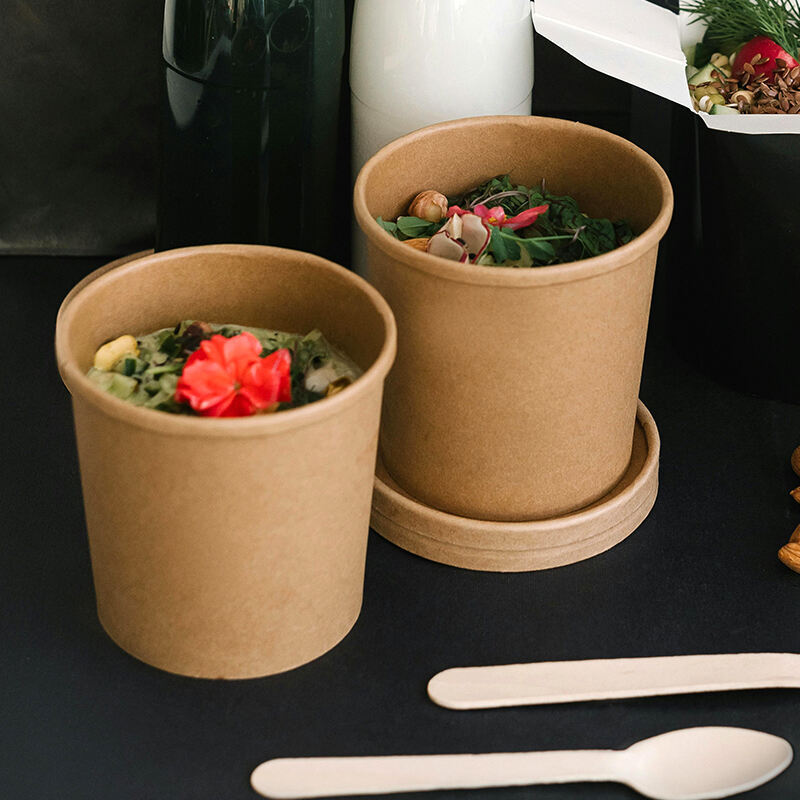Understanding the Environmental Impact of Disposable Dinnerware
As environmental consciousness grows, consumers and businesses alike are seeking sustainable alternatives to traditional disposable products. Paper bowls have emerged as a leading eco-friendly solution in the food service industry, offering a compelling balance between convenience and environmental responsibility. These versatile containers are revolutionizing how we think about single-use dining options while maintaining the practicality that modern lifestyles demand.
The Environmental Benefits of Paper Bowls
Biodegradable Properties and Natural Decomposition
Paper bowls stand out for their exceptional biodegradability. Unlike plastic alternatives that can take hundreds of years to break down, paper bowls naturally decompose within weeks to months under proper conditions. This rapid decomposition process significantly reduces the burden on landfills and minimizes long-term environmental impact. The organic materials used in paper bowls return to the earth, completing a natural cycle that aligns with ecological principles.
The decomposition process of paper bowls produces minimal harmful byproducts, as they're typically made from renewable wood pulp or recycled paper materials. This natural breakdown process contributes to soil enrichment rather than soil contamination, making paper bowls an environmentally responsible choice for both consumers and businesses.
Sustainable Manufacturing Processes
The production of paper bowls involves significantly less environmental impact compared to plastic alternatives. Modern manufacturing facilities employ advanced techniques that minimize water usage and maximize energy efficiency. Many manufacturers have implemented closed-loop systems that recycle water and reduce waste throughout the production process.
Additionally, responsible paper bowl manufacturers increasingly use renewable energy sources and sustainable forestry practices. This commitment to environmental stewardship ensures that the production of paper bowls maintains a smaller carbon footprint while supporting forest conservation efforts.
Material Innovation and Sustainability
Advanced Coating Technologies
Modern paper bowls feature innovative coating solutions that enhance their functionality while maintaining their eco-friendly properties. These advanced coatings provide excellent moisture resistance and durability without compromising the bowl's biodegradability. Manufacturers have developed plant-based barriers and natural sealants that replace traditional petroleum-based alternatives, further reducing environmental impact.
These technological advancements ensure that paper bowls can handle hot soups, salads, and other food items effectively while remaining completely compostable. The marriage of functionality and sustainability demonstrates the industry's commitment to meeting consumer needs without environmental compromise.
Recycled Content Integration
Leading manufacturers are incorporating increasing amounts of recycled content into their paper bowls, creating a circular economy approach to production. This practice not only reduces the demand for virgin materials but also provides a valuable end-use for recycled paper products. The integration of recycled content maintains product quality while significantly reducing environmental impact.
The use of recycled materials in paper bowls helps close the loop in waste management systems and demonstrates the versatility of paper as a renewable resource. This approach supports broader recycling initiatives and encourages consumers to participate in sustainable practices.

Commercial and Consumer Benefits
Cost-Effective Environmental Solutions
Paper bowls offer businesses a cost-effective way to demonstrate environmental responsibility without sacrificing quality or convenience. The competitive pricing of paper bowls, combined with their positive environmental impact, makes them an attractive option for restaurants, cafeterias, and food service providers. Many establishments find that switching to paper bowls enhances their brand image while meeting customer expectations for sustainable practices.
The lightweight nature of paper bowls also reduces shipping costs and storage requirements compared to heavier alternatives. This efficiency in transportation and storage contributes to both economic and environmental benefits throughout the supply chain.
Consumer Satisfaction and Environmental Awareness
Modern consumers increasingly seek products that align with their environmental values. Paper bowls meet this demand by providing a tangible way for individuals to reduce their environmental impact in daily life. The visual and tactile experience of using paper bowls often reinforces positive environmental choices, encouraging continued sustainable behavior.
Consumers appreciate the familiar feel and practical benefits of paper bowls while knowing they're making an environmentally responsible choice. This satisfaction drives continued adoption and helps establish sustainable practices as the new normal in disposable dining options.
Future Developments and Industry Trends
Innovative Material Science
The paper bowl industry continues to invest in research and development, exploring new materials and manufacturing processes that further reduce environmental impact. Scientists are investigating novel fiber sources, including agricultural waste and fast-growing plant species, to create even more sustainable paper products. These innovations promise to enhance the eco-friendly properties of paper bowls while maintaining or improving their performance characteristics.
Emerging technologies in barrier coatings and structural design are also advancing the capabilities of paper bowls. These developments focus on creating products that offer enhanced functionality while ensuring complete biodegradability and minimal environmental impact.
Market Growth and Environmental Impact
The market for paper bowls continues to expand as environmental regulations tighten and consumer awareness grows. This growth drives further innovation and investment in sustainable manufacturing practices. Industry leaders are establishing new standards for environmental responsibility, influencing the entire disposable container market toward more sustainable solutions.
As production scales increase, the cost-effectiveness of paper bowls improves, making them an increasingly attractive option for businesses of all sizes. This positive feedback loop accelerates the transition away from less sustainable alternatives, contributing to meaningful environmental change.
Frequently Asked Questions
Are paper bowls truly biodegradable?
Yes, paper bowls are biodegradable when properly disposed of in appropriate conditions. Most paper bowls will decompose naturally within 2-6 months in a commercial composting facility, though exact timing depends on specific materials and conditions.
Can paper bowls handle hot foods and liquids?
Modern paper bowls are designed with heat-resistant properties and protective coatings that allow them to safely contain hot foods and liquids without leaking or losing structural integrity. They can typically handle temperatures up to 185°F (85°C).
How do paper bowls compare to plastic in terms of environmental impact?
Paper bowls have a significantly lower environmental impact than plastic alternatives. They require less energy to produce, decompose much faster, and don't contribute to long-term plastic pollution. Additionally, their production often involves sustainable forestry practices and renewable resources.
